2017 YAMAHA VIKING trailer
[x] Cancel search: trailerPage 57 of 172
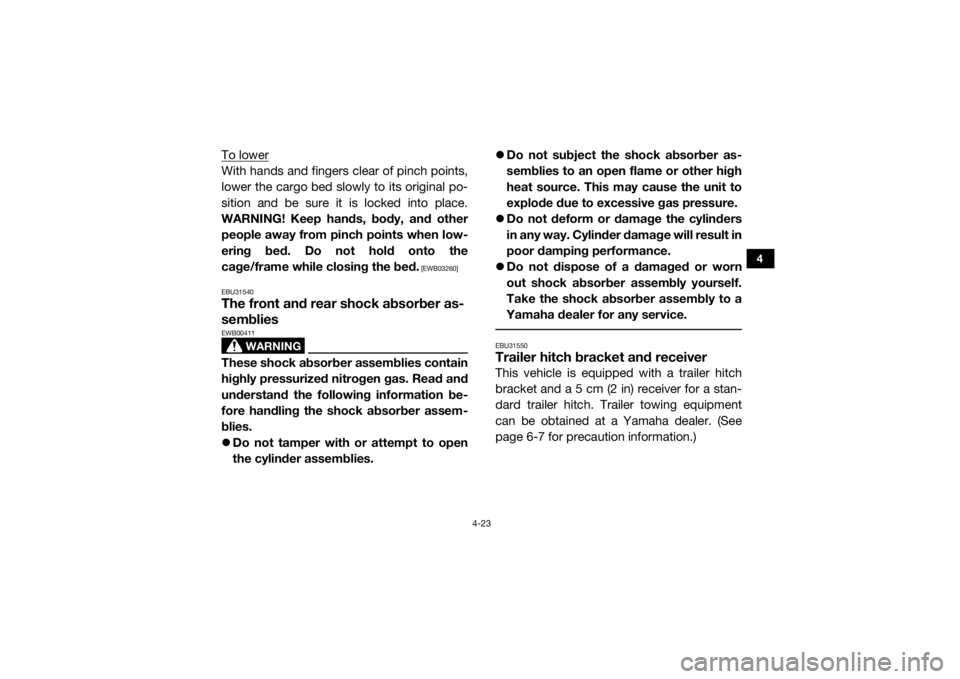
4-23
4
To lowerWith hands and fingers clear of pinch points,
lower the cargo bed slowly to its original po-
sition and be sure it is locked into place.
WARNING! Keep hands, body, and other
people away from pinch points when low-
ering bed. Do not hold onto the
cage/frame while closing the bed.
[EWB03260]
EBU31540
The front and rear shock absorber as-
semblies
WARNING
EWB00411These shock absorber assemblies contain
highly pressurized nitrogen gas. Read and
understand the following information be-
fore handling the shock absorber assem-
blies.
Do not tamper with or attempt to open
the cylinder assemblies.
Do not subject the shock absorber as-
semblies to an open flame or other high
heat source. This may cause the unit to
explode due to excessive gas pressure.
Do not deform or damage the cylinders
in any way. Cylinder damage will result in
poor damping performance.
Do not dispose of a damaged or worn
out shock absorber assembly yourself.
Take the shock absorber assembly to a
Yamaha dealer for any service.
EBU31550Trailer hitch bracket and receiverThis vehicle is equipped with a trailer hitch
bracket and a 5 cm (2 in) receiver for a stan-
dard trailer hitch. Trailer towing equipment
can be obtained at a Yamaha dealer. (See
page 6-7 for precaution information.)
UB427BE0.book Page 23 Friday, February 5, 2016 2:14 PM
Page 58 of 172
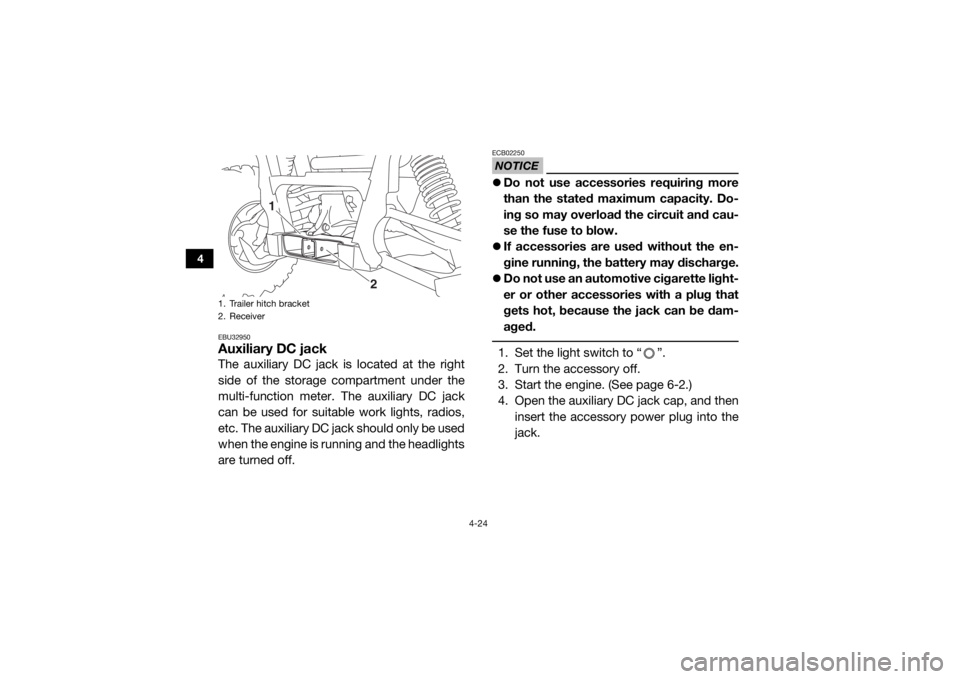
4-24
4
EBU32950Auxiliary DC jackThe auxiliary DC jack is located at the right
side of the storage compartment under the
multi-function meter. The auxiliary DC jack
can be used for suitable work lights, radios,
etc. The auxiliary DC jack should only be used
when the engine is running and the headlights
are turned off.
NOTICEECB02250Do not use accessories requiring more
than the stated maximum capacity. Do-
ing so may overload the circuit and cau-
se the fuse to blow.
If accessories are used without the en-
gine running, the battery may discharge.
Do not use an automotive cigarette light-
er or other accessories with a plug that
gets hot, because the jack can be dam-
aged. 1. Set the light switch to “ ”.
2. Turn the accessory off.
3. Start the engine. (See page 6-2.)
4. Open the auxiliary DC jack cap, and then
insert the accessory power plug into the
jack.
1. Trailer hitch bracket
2. Receiver
2
1
UB427BE0.book Page 24 Friday, February 5, 2016 2:14 PM
Page 68 of 172
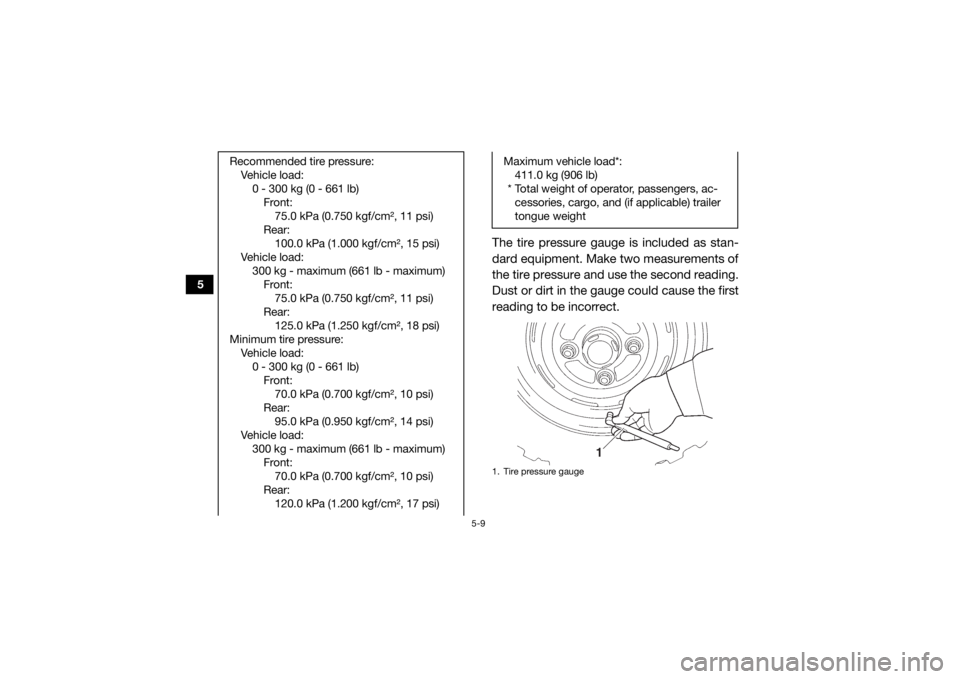
5-9
5
The tire pressure gauge is included as stan-
dard equipment. Make two measurements of
the tire pressure and use the second reading.
Dust or dirt in the gauge could cause the first
reading to be incorrect.
Recommended tire pressure:Vehicle load:0 - 300 kg (0 - 661 lb)Front: 75.0 kPa (0.750 kgf/cm², 11 psi)
Rear: 100.0 kPa (1.000 kgf/cm², 15 psi)
Vehicle load: 300 kg - maximum (661 lb - maximum)Front: 75.0 kPa (0.750 kgf/cm², 11 psi)
Rear: 125.0 kPa (1.250 kgf/cm², 18 psi)
Minimum tire pressure: Vehicle load:0 - 300 kg (0 - 661 lb)Front: 70.0 kPa (0.700 kgf/cm², 10 psi)
Rear: 95.0 kPa (0.950 kgf/cm², 14 psi)
Vehicle load: 300 kg - maximum (661 lb - maximum)Front: 70.0 kPa (0.700 kgf/cm², 10 psi)
Rear: 120.0 kPa (1.200 kgf/cm², 17 psi)
Maximum vehicle load*:411.0 kg (906 lb)
* Total weight of operator, passengers, ac- cessories, cargo, and (if applicable) trailer
tongue weight1. Tire pressure gauge
1
UB427BE0.book Page 9 Friday, February 5, 2016 2:14 PM
Page 76 of 172
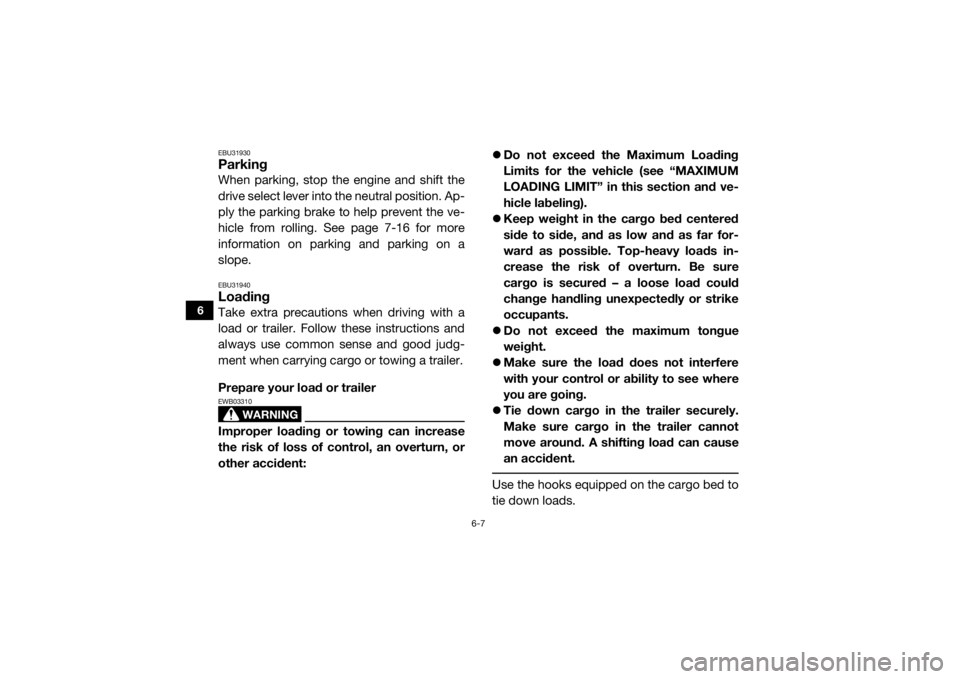
6-7
6
EBU31930ParkingWhen parking, stop the engine and shift the
drive select lever into the neutral position. Ap-
ply the parking brake to help prevent the ve-
hicle from rolling. See page 7-16 for more
information on parking and parking on a
slope.EBU31940LoadingTake extra precautions when driving with a
load or trailer. Follow these instructions and
always use common sense and good judg-
ment when carrying cargo or towing a trailer.
Prepare your load or trailer
WARNING
EWB03310Improper loading or towing can increase
the risk of loss of control, an overturn, or
other accident:
Do not exceed the Maximum Loading
Limits for the vehicle (see “MAXIMUM
LOADING LIMIT” in this section and ve-
hicle labeling).
Keep weight in the cargo bed centered
side to side, and as low and as far for-
ward as possible. Top-heavy loads in-
crease the risk of overturn. Be sure
cargo is secured – a loose load could
change handling unexpectedly or strike
occupants.
Do not exceed the maximum tongue
weight.
Make sure the load does not interfere
with your control or ability to see where
you are going.
Tie down cargo in the trailer securely.
Make sure cargo in the trailer cannot
move around. A shifting load can cause
an accident.
Use the hooks equipped on the cargo bed to
tie down loads.
UB427BE0.book Page 7 Friday, February 5, 2016 2:14 PM
Page 77 of 172
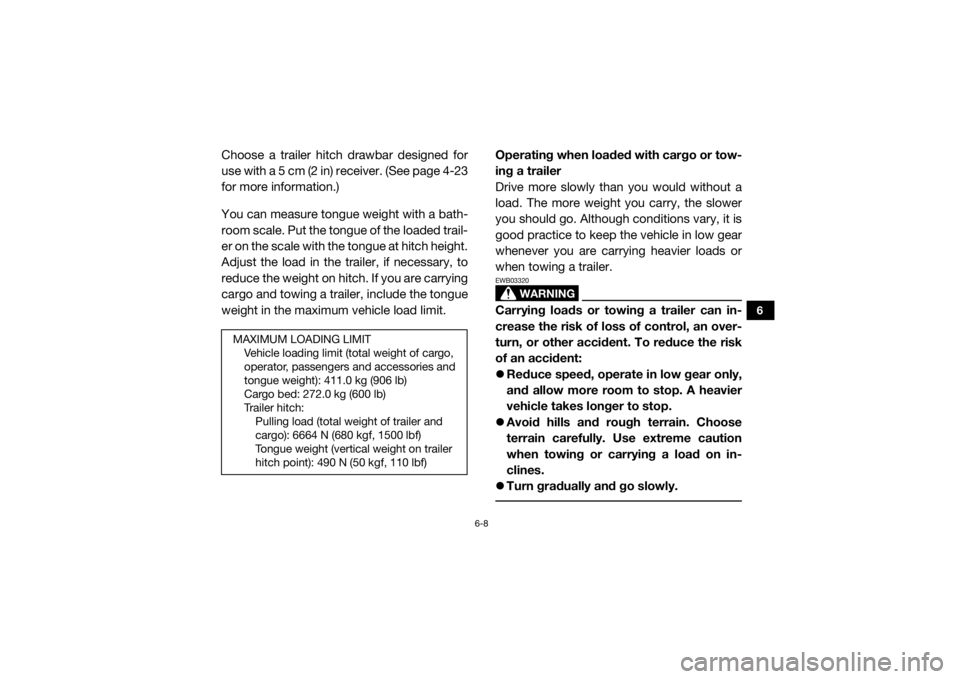
6-8
6
Choose a trailer hitch drawbar designed for
use with a 5 cm (2 in) receiver. (See page 4-23
for more information.)
You can measure tongue weight with a bath-
room scale. Put the tongue of the loaded trail-
er on the scale with the tongue at hitch height.
Adjust the load in the trailer, if necessary, to
reduce the weight on hitch. If you are carrying
cargo and towing a trailer, include the tongue
weight in the maximum vehicle load limit.Operating when loaded with cargo or tow-
ing a trailer
Drive more slowly than you would without a
load. The more weight you carry, the slower
you should go. Although conditions vary, it is
good practice to keep the vehicle in low gear
whenever you are carrying heavier loads or
when towing a trailer.
WARNING
EWB03320Carrying loads or towing a trailer can in-
crease the risk of loss of control, an over-
turn, or other acciden
t. To reduce the risk
of an accident:
Reduce speed, operate in low gear only,
and allow more room to stop. A heavier
vehicle takes longer to stop.
Avoid hills and rough terrain. Choose
terrain carefully. Use extreme caution
when towing or carrying a load on in-
clines.
Turn gradually and go slowly.
MAXIMUM LOADING LIMIT
Vehicle loading limit (total weight of cargo,
operator, passengers and accessories and
tongue weight): 411.0 kg (906 lb)
Cargo bed: 272.0 kg (600 lb)
Tr a i l e r h i t c h :Pulling load (total weight of trailer and
cargo): 6664 N (680 kgf, 1500 lbf)
Tongue weight (vertical weight on trailer
hitch point): 490 N (50 kgf, 110 lbf)
UB427BE0.book Page 8 Friday, February 5, 2016 2:14 PM
Page 78 of 172

6-9
6
Pulling something other than a trailer
Yamaha recommends that loads be trans-
ported in the bed or in a trailer. If you need to
move an object a short distance use a winch
and follow the winch manufacturer’s instruc-
tions.
If you choose to use something other than a
winch use extreme caution, follow the manu-
facturer’s instructions for that product, and
only attach to the hitch or hitch bracket of the
Viking. WARNING! Improperly pulling can
cause serious injury or death. Never ex-
ceed the pulling load limit of the Viking.
Avoid pulling on inclines.
[EWB03330]
Pulling objects on the ground can be more
hazardous than pulling a trailer. It may be dif-
ficult to predict how the load will affect vehicle
operation. That effect could also change de-
pending upon terrain or what obstacles might
be in the object’s path.UB427BE0.book Page 9 Friday, February 5, 2016 2:14 PM
Page 94 of 172

7-16
7
Parking on a flat area
When parking on a flat area, stop the engine
and shift the drive select lever into the neutral
position. Apply the parking brake to help pre-
vent the vehicle from rolling.
Parking on a slope
The parking brake acts only on the rear
wheels when in “2WD”. For the parking brake
to take effect on all four wheels, shift to “DIFF
LOCK” before stopping the engine.
If you park on a hill that is too steep the vehi-
cle may roll out of control. Never park on hills
that are so steep you cannot walk up them
easily. If you must park on an incline follow
these instructions:1. Bring the vehicle to a stop by applying the brake pedal.
2. Put the vehicle in “DIFF LOCK”.
3. Turn the key to “ ” (off).
4. With the brake pedal applied, set the parking brake. 5. Block the front and rear wheels with
rocks or other objects.
Loading
The total weight of operator, passengers, ac-
cessories, cargo, trailer tongue weight, and
the vehicle itself must not exceed 1080 kg
(2381 lb). Vehicle loading can affect handling.
See “Loading” on page 6-7.
EBU33360Operation on different surfaces and
terrainsGo slowly and proceed with caution when op-
erating on an unfamiliar surface or terrain.
This vehicle may handle differently in certain
types of terrains or on certain surfaces. You
may come upon hidden rocks, bumps, or
holes without enough time to react. To avoid
loss of control or rollover, always be alert to
changing surfaces or terrain when operating
the vehicle.
UB427BE0.book Page 16 Friday, February 5, 2016 2:14 PM
Page 169 of 172

12-2
12
IIdentification number records ...................................... 11-1
Indicator lights and warning lights ................................. 4-2
Instruments, lights and switches, Pre-operation check ........................................................................... 5-7JJump-starting .............................................................. 8-46LLabel locations ............................................................... 1-1
Light switch .................................................................. 4-10
Loading .......................................................................... 6-7
Low-range indicator light ............................................... 4-2MMain switch .................................................................... 4-1
Maintenance and lubrication chart ................................ 8-6
Maintenance chart, emission control system ................ 8-4
Model label .................................................................. 11-1
Multi-function meter unit ............................................... 4-6NNeutral indicator light ..................................................... 4-3OOn-Command drive knob ............................................ 4-11
On-Command drive knob, operation ............................. 6-5
On-Command four-wheel-drive/differential gear lock indicator ....................................................................... 4-3
Owner’s manual and tool kit .......................................... 8-2PParking ........................................................................... 6-7
Parking brake indicator light .......................................... 4-3
Parking brake lever ...................................................... 4-13
Parking brake lever free play, adjusting ....................... 8-36 Parking brake pads, checking ..................................... 8-34
Passenger handhold, Pre-operation check ................... 5-7
RRear knuckle upper and lower pivot, lubrication ......... 8-39
Reverse indicator light ................................................... 4-3SSafety information .......................................................... 2-1
Seat belt indicator light .................................................. 4-5
Seat belts ..................................................................... 4-17
Seat belts, Pre-operation check .................................... 5-6
Seats ............................................................................ 4-15
Spark arrester, cleaning ............................................... 8-31
Spark plug, inspecting ................................................. 8-23
Specifications .............................................................. 10-1
Stabilizer bushes, checking ..........
............................... 8-39
Starting the engine ........................................................ 6-2
Steering, Pre-operation check ....................................... 5-7
Steering shaft, lubrication ............................................ 8-40
Storage .......................................................................... 9-2
Storage compartments ................................................ 4-18TTail/brake light bulb, replacing .................................... 8-53
Tire, replacing .............................................................. 8-41
Tires, Pre-operation check ............................................ 5-8
Trailer hitch bracket and receiver ................................ 4-23
Troubleshooting ........................................................... 8-54
Troubleshooting charts ................................................ 8-56VValve clearance ............................................................ 8-33
V-belt case drain plug .................................................. 8-31
Vehicle identification number ...................................... 11-1
UB427BE0.book Page 2 Friday, February 5, 2016 2:14 PM